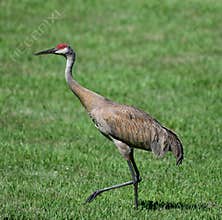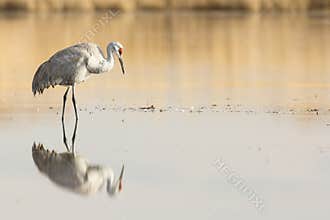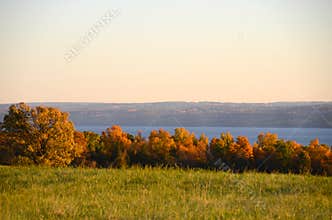Sandhill Crane Walking In Marsh Grass Habitat In Nys. Sandhill Cranes Are Very Large, Tall Birds With A Long Neck, Long Legs, And Very Broad Wings. The Bulky Body Tapers Into A Slender Neck The Short Tail Is Covered By Drooping Feathers That Form A “Bustle.” The Head Is Small And The Bill Is Straight And Longer Than The Head. These Are Slate Gray Birds, Often With A Rusty Wash On The Upperparts. Adults Have A Pale Cheek And Red Skin On The Crown. Their Legs Are Black. Juveniles Are Gray And Rusty Brown, Without The Pale Cheek Or Red Crown. Sandhill Cranes Forage For Grains And Invertebrates In Prairies, Grasslands, And Marshes. They Breed And Forage In Open Prairies, Grasslands, And Wetlands. Outside Of The Breeding Season, They Often Roost In Deeper Water Of Ponds Or Lakes, Where They Are Safe From Predators.the Montezuma National Wildlife Refuge Has Diverse Habitats Of Wetland, Grassland, Shrubland And Forest Give Food, Shelter, Water And Space To Many Of Central New York’s Wildlife Species. Waterfowl And Other Migratory Birds Depend On The Refuge As Nesting, Feeding, Breeding And Stopover Grounds On The Atlantic Flyway Zone.
ID 966616716725 © Mccrainemercantile | Megapixl.com
Sharing is not just caring, it's also about giving credit - add this image to your page and give credit to the talented photographer who captured it.:
KEYWORDS
bird wildlife animal beak wetland waterbird wing nature plant swamp waterfowl grass sandhill crane montezuma refuge cayugalake cayuga nys upstateny marshland feathers bustle adult marsh water biology ornithology natural habitat wetlands atlanticflywayzone migration fish service birding hotspot ebird fingerlakes flx senecafalls migrate flocks fall autumn stopover grey shrubland eastcoast newyorkstate centralnewyork cny nwr








































